Talent Management Practices for Enhancing Performance - M&S Study
VerifiedAdded on 2023/06/17
|5
|925
|471
Project
AI Summary
This project proposal focuses on identifying effective talent management practices to enhance organizational performance, using Marks & Spencer as a case study. The aim is to explore strategies for attracting, managing, and retaining skilled employees to improve productivity and overall business outcomes. The project outlines objectives to discuss the concept and benefits of talent management, explore strategies for retaining employees, and suggest best practices for Marks & Spencer. The proposal includes a literature review of relevant concepts, activities, and a timeline, along with milestones for tracking progress and a glossary of key terms. The research aims to provide insights for retailers to improve staff retention rates and enhance customer satisfaction through effective talent management strategies.
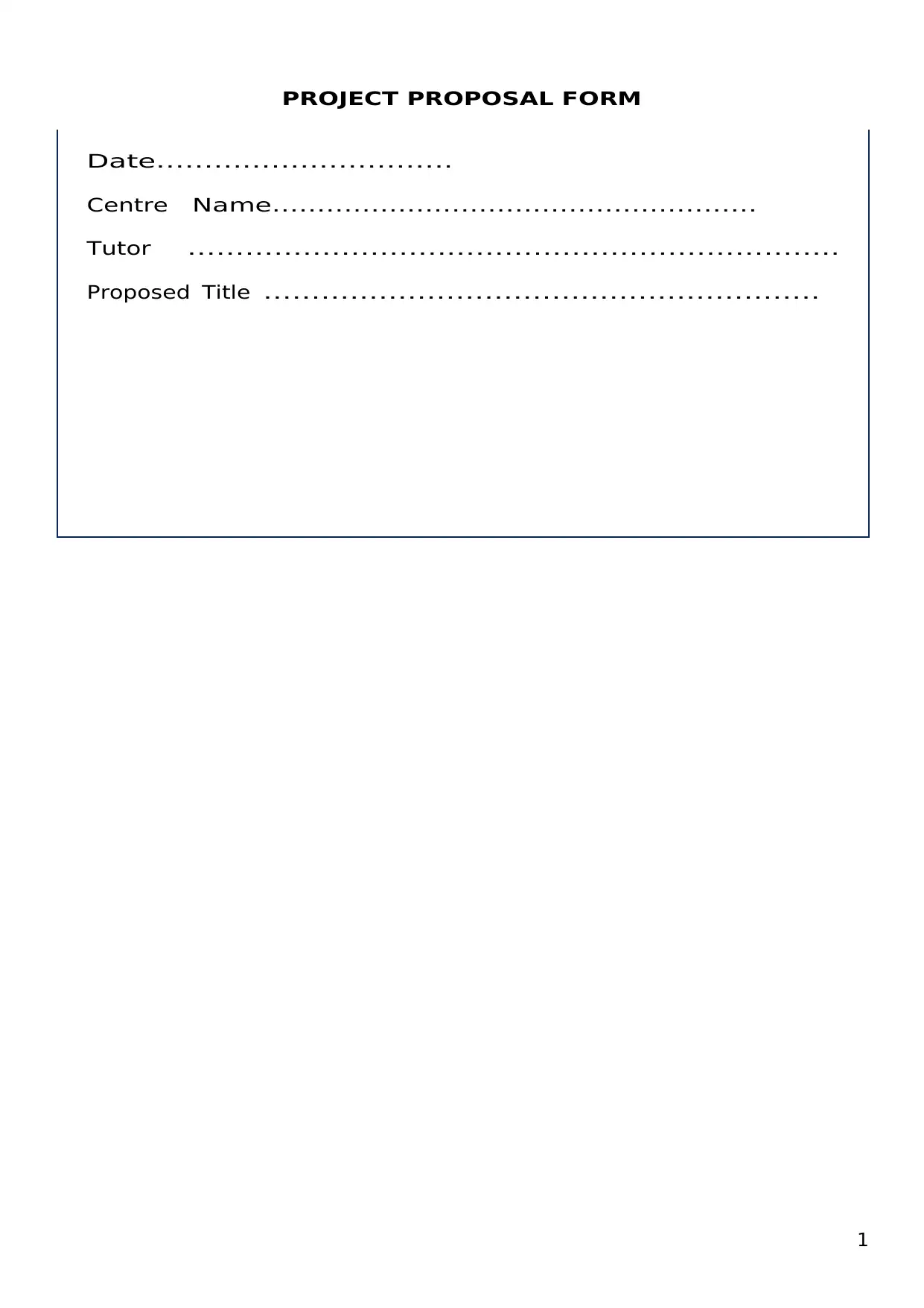
1
PROJECT PROPOSAL FORM
Date………………………….
Centre Name………………………………………………
Tutor …………………………………………………………..
Proposed Title ………………………………………………….
PROJECT PROPOSAL FORM
Date………………………….
Centre Name………………………………………………
Tutor …………………………………………………………..
Proposed Title ………………………………………………….
Paraphrase This Document
Need a fresh take? Get an instant paraphrase of this document with our AI Paraphraser
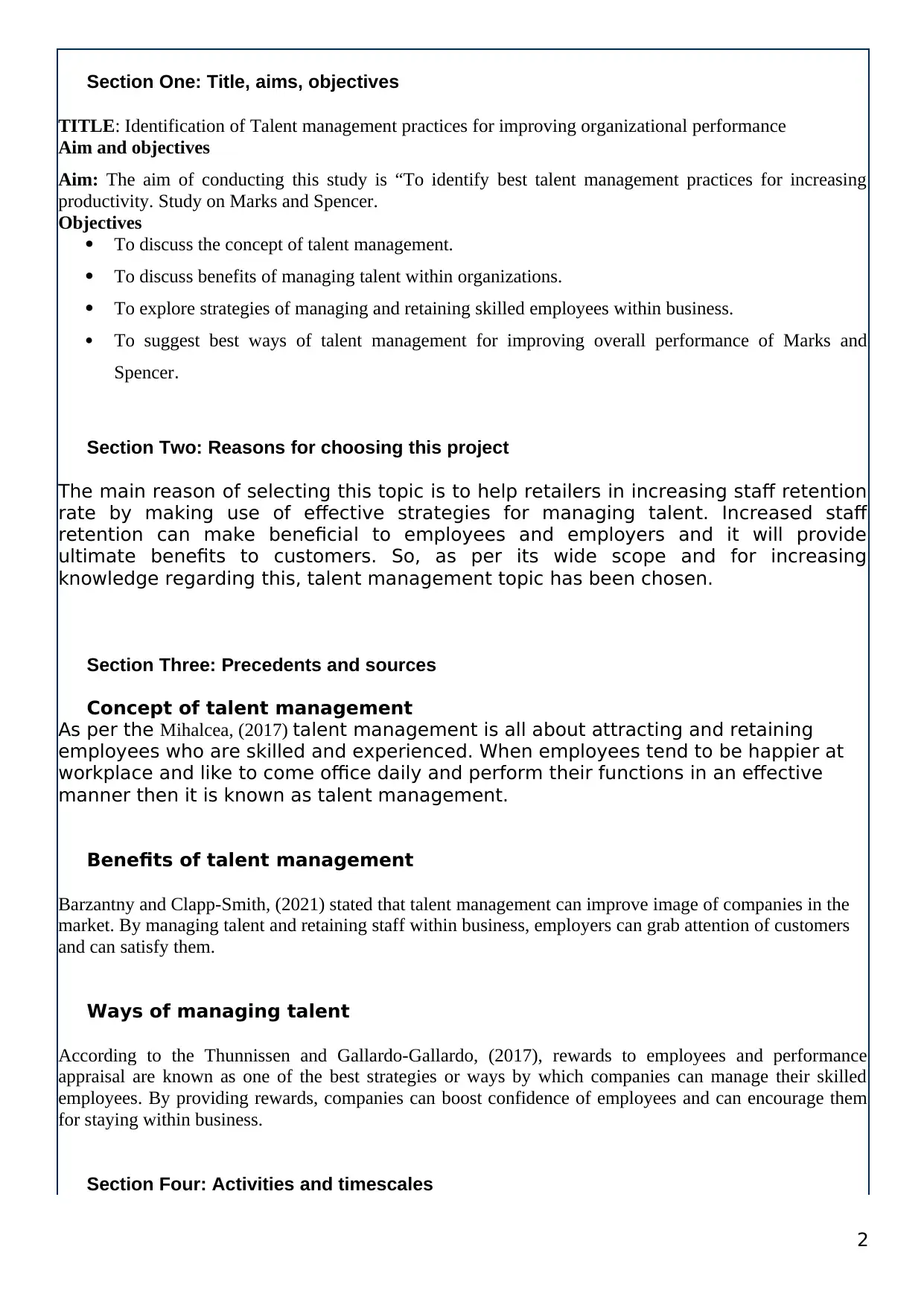
2
Section One: Title, aims, objectives
TITLE: Identification of Talent management practices for improving organizational performance
Aim and objectives
Aim: The aim of conducting this study is “To identify best talent management practices for increasing
productivity. Study on Marks and Spencer.
Objectives
To discuss the concept of talent management.
To discuss benefits of managing talent within organizations.
To explore strategies of managing and retaining skilled employees within business.
To suggest best ways of talent management for improving overall performance of Marks and
Spencer.
Section Two: Reasons for choosing this project
The main reason of selecting this topic is to help retailers in increasing staff retention
rate by making use of effective strategies for managing talent. Increased staff
retention can make beneficial to employees and employers and it will provide
ultimate benefits to customers. So, as per its wide scope and for increasing
knowledge regarding this, talent management topic has been chosen.
Section Three: Precedents and sources
Concept of talent management
As per the Mihalcea, (2017) talent management is all about attracting and retaining
employees who are skilled and experienced. When employees tend to be happier at
workplace and like to come office daily and perform their functions in an effective
manner then it is known as talent management.
Benefits of talent management
Barzantny and Clapp-Smith, (2021) stated that talent management can improve image of companies in the
market. By managing talent and retaining staff within business, employers can grab attention of customers
and can satisfy them.
Ways of managing talent
According to the Thunnissen and Gallardo-Gallardo, (2017), rewards to employees and performance
appraisal are known as one of the best strategies or ways by which companies can manage their skilled
employees. By providing rewards, companies can boost confidence of employees and can encourage them
for staying within business.
Section Four: Activities and timescales
Section One: Title, aims, objectives
TITLE: Identification of Talent management practices for improving organizational performance
Aim and objectives
Aim: The aim of conducting this study is “To identify best talent management practices for increasing
productivity. Study on Marks and Spencer.
Objectives
To discuss the concept of talent management.
To discuss benefits of managing talent within organizations.
To explore strategies of managing and retaining skilled employees within business.
To suggest best ways of talent management for improving overall performance of Marks and
Spencer.
Section Two: Reasons for choosing this project
The main reason of selecting this topic is to help retailers in increasing staff retention
rate by making use of effective strategies for managing talent. Increased staff
retention can make beneficial to employees and employers and it will provide
ultimate benefits to customers. So, as per its wide scope and for increasing
knowledge regarding this, talent management topic has been chosen.
Section Three: Precedents and sources
Concept of talent management
As per the Mihalcea, (2017) talent management is all about attracting and retaining
employees who are skilled and experienced. When employees tend to be happier at
workplace and like to come office daily and perform their functions in an effective
manner then it is known as talent management.
Benefits of talent management
Barzantny and Clapp-Smith, (2021) stated that talent management can improve image of companies in the
market. By managing talent and retaining staff within business, employers can grab attention of customers
and can satisfy them.
Ways of managing talent
According to the Thunnissen and Gallardo-Gallardo, (2017), rewards to employees and performance
appraisal are known as one of the best strategies or ways by which companies can manage their skilled
employees. By providing rewards, companies can boost confidence of employees and can encourage them
for staying within business.
Section Four: Activities and timescales
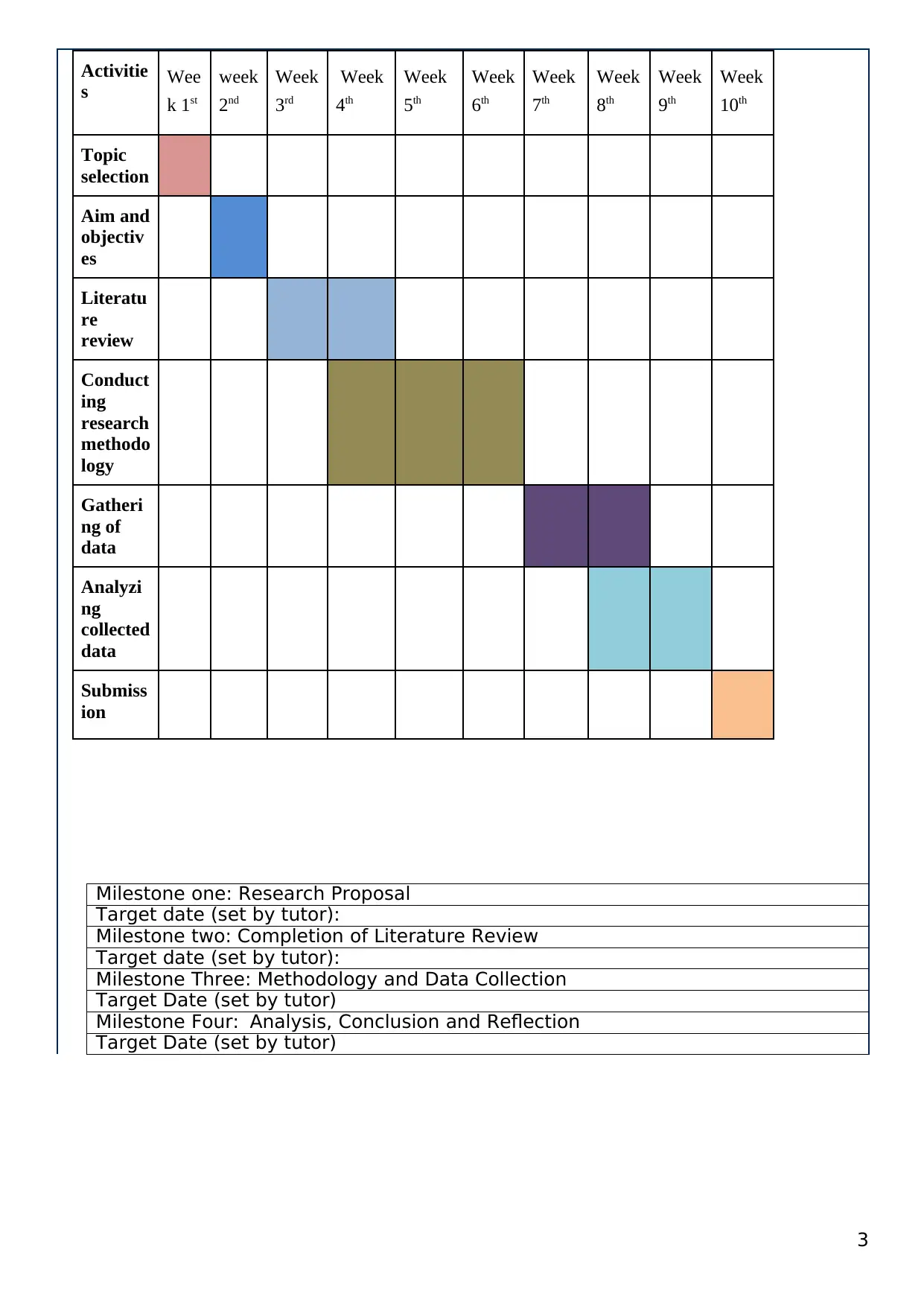
3
Activitie
s Wee
k 1st
week
2nd
Week
3rd
Week
4th
Week
5th
Week
6th
Week
7th
Week
8th
Week
9th
Week
10th
Topic
selection
Aim and
objectiv
es
Literatu
re
review
Conduct
ing
research
methodo
logy
Gatheri
ng of
data
Analyzi
ng
collected
data
Submiss
ion
Milestone one: Research Proposal
Target date (set by tutor):
Milestone two: Completion of Literature Review
Target date (set by tutor):
Milestone Three: Methodology and Data Collection
Target Date (set by tutor)
Milestone Four: Analysis, Conclusion and Reflection
Target Date (set by tutor)
Activitie
s Wee
k 1st
week
2nd
Week
3rd
Week
4th
Week
5th
Week
6th
Week
7th
Week
8th
Week
9th
Week
10th
Topic
selection
Aim and
objectiv
es
Literatu
re
review
Conduct
ing
research
methodo
logy
Gatheri
ng of
data
Analyzi
ng
collected
data
Submiss
ion
Milestone one: Research Proposal
Target date (set by tutor):
Milestone two: Completion of Literature Review
Target date (set by tutor):
Milestone Three: Methodology and Data Collection
Target Date (set by tutor)
Milestone Four: Analysis, Conclusion and Reflection
Target Date (set by tutor)
⊘ This is a preview!⊘
Do you want full access?
Subscribe today to unlock all pages.

Trusted by 1+ million students worldwide
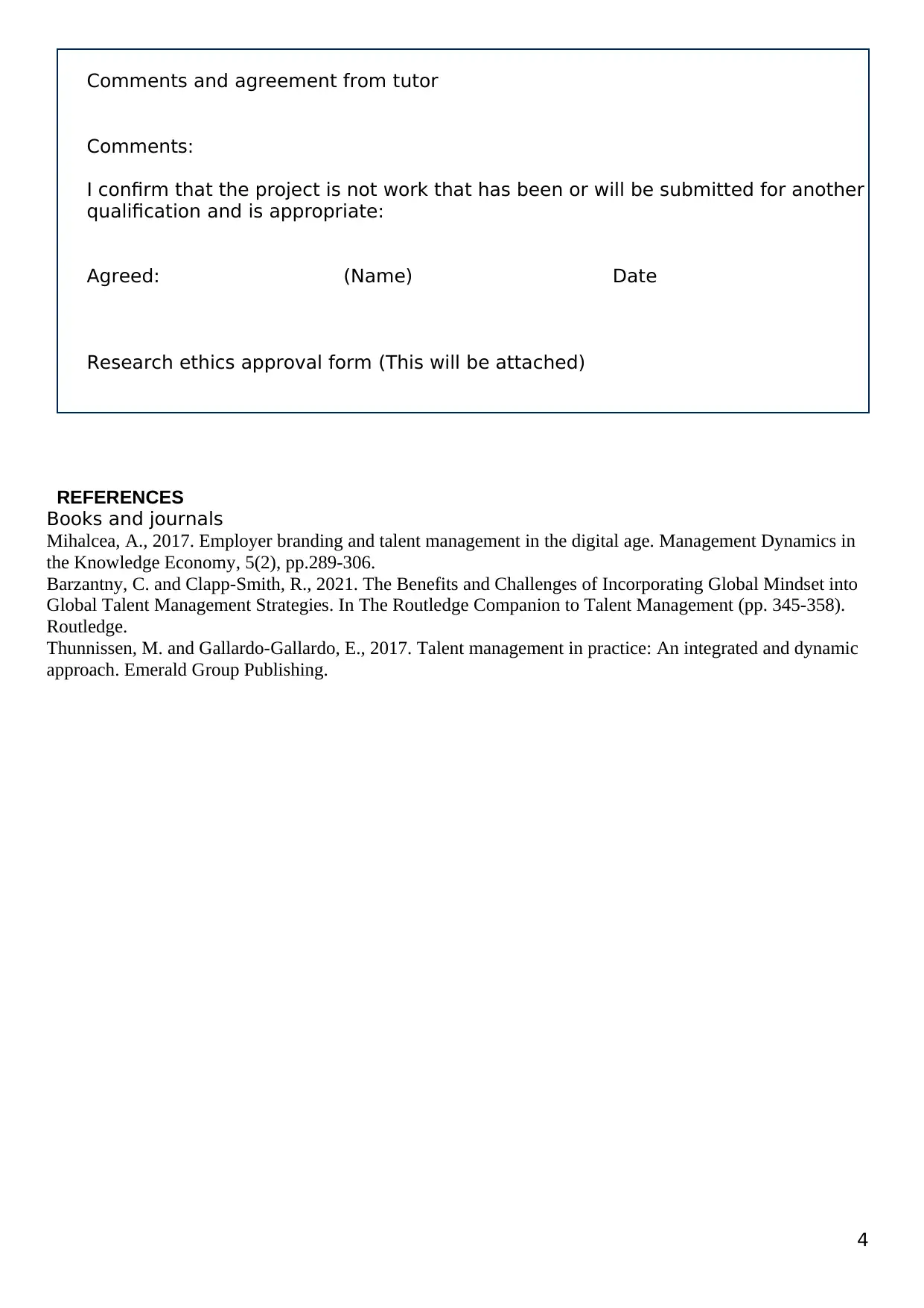
4
Comments and agreement from tutor
Comments:
I confirm that the project is not work that has been or will be submitted for another
qualification and is appropriate:
Agreed: (Name) Date
Research ethics approval form (This will be attached)
REFERENCES
Books and journals
Mihalcea, A., 2017. Employer branding and talent management in the digital age. Management Dynamics in
the Knowledge Economy, 5(2), pp.289-306.
Barzantny, C. and Clapp-Smith, R., 2021. The Benefits and Challenges of Incorporating Global Mindset into
Global Talent Management Strategies. In The Routledge Companion to Talent Management (pp. 345-358).
Routledge.
Thunnissen, M. and Gallardo-Gallardo, E., 2017. Talent management in practice: An integrated and dynamic
approach. Emerald Group Publishing.
Comments and agreement from tutor
Comments:
I confirm that the project is not work that has been or will be submitted for another
qualification and is appropriate:
Agreed: (Name) Date
Research ethics approval form (This will be attached)
REFERENCES
Books and journals
Mihalcea, A., 2017. Employer branding and talent management in the digital age. Management Dynamics in
the Knowledge Economy, 5(2), pp.289-306.
Barzantny, C. and Clapp-Smith, R., 2021. The Benefits and Challenges of Incorporating Global Mindset into
Global Talent Management Strategies. In The Routledge Companion to Talent Management (pp. 345-358).
Routledge.
Thunnissen, M. and Gallardo-Gallardo, E., 2017. Talent management in practice: An integrated and dynamic
approach. Emerald Group Publishing.
Paraphrase This Document
Need a fresh take? Get an instant paraphrase of this document with our AI Paraphraser
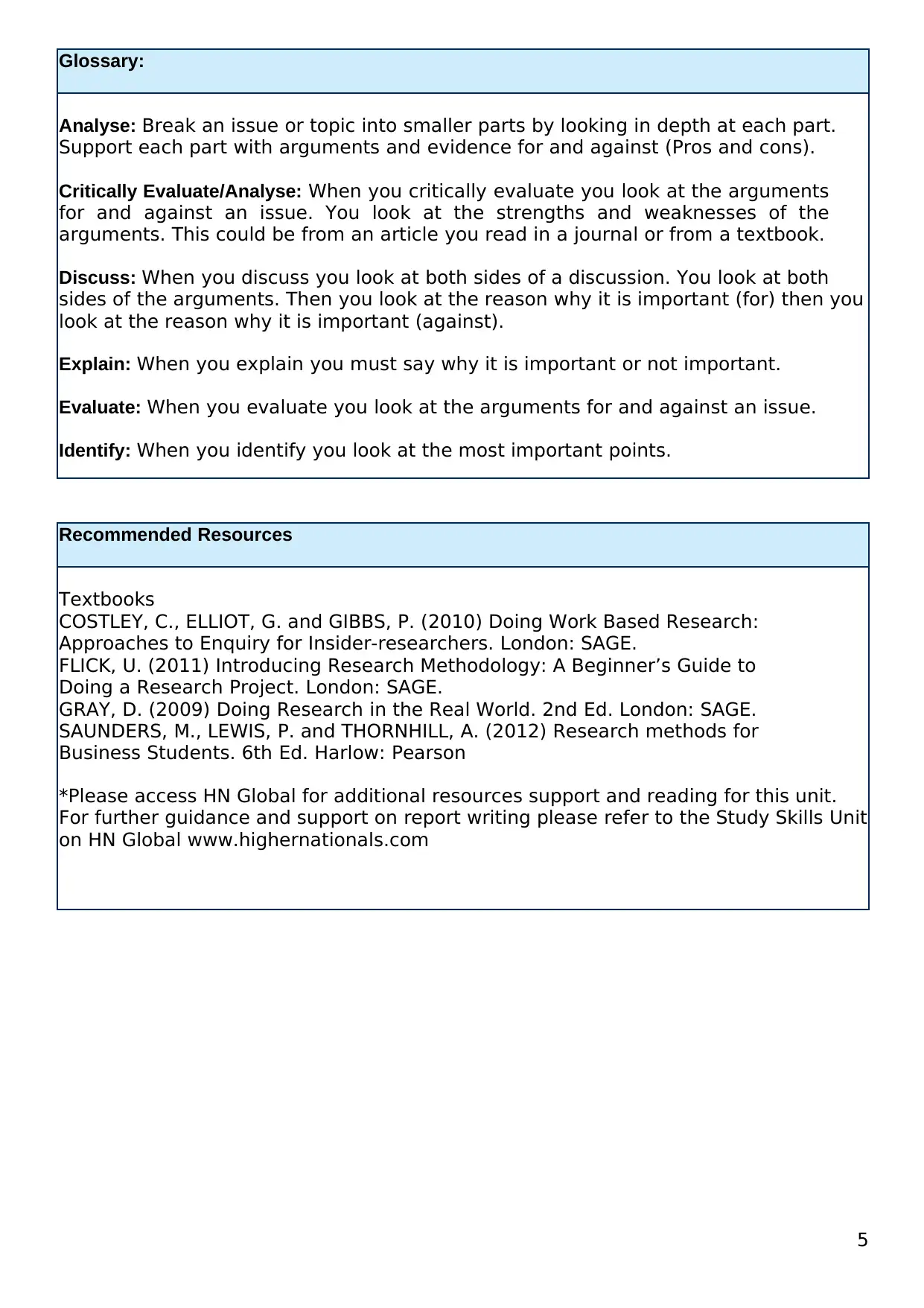
5
Glossary:
Analyse: Break an issue or topic into smaller parts by looking in depth at each part.
Support each part with arguments and evidence for and against (Pros and cons).
Critically Evaluate/Analyse: When you critically evaluate you look at the arguments
for and against an issue. You look at the strengths and weaknesses of the
arguments. This could be from an article you read in a journal or from a textbook.
Discuss: When you discuss you look at both sides of a discussion. You look at both
sides of the arguments. Then you look at the reason why it is important (for) then you
look at the reason why it is important (against).
Explain: When you explain you must say why it is important or not important.
Evaluate: When you evaluate you look at the arguments for and against an issue.
Identify: When you identify you look at the most important points.
Recommended Resources
Textbooks
COSTLEY, C., ELLIOT, G. and GIBBS, P. (2010) Doing Work Based Research:
Approaches to Enquiry for Insider-researchers. London: SAGE.
FLICK, U. (2011) Introducing Research Methodology: A Beginner’s Guide to
Doing a Research Project. London: SAGE.
GRAY, D. (2009) Doing Research in the Real World. 2nd Ed. London: SAGE.
SAUNDERS, M., LEWIS, P. and THORNHILL, A. (2012) Research methods for
Business Students. 6th Ed. Harlow: Pearson
*Please access HN Global for additional resources support and reading for this unit.
For further guidance and support on report writing please refer to the Study Skills Unit
on HN Global www.highernationals.com
Glossary:
Analyse: Break an issue or topic into smaller parts by looking in depth at each part.
Support each part with arguments and evidence for and against (Pros and cons).
Critically Evaluate/Analyse: When you critically evaluate you look at the arguments
for and against an issue. You look at the strengths and weaknesses of the
arguments. This could be from an article you read in a journal or from a textbook.
Discuss: When you discuss you look at both sides of a discussion. You look at both
sides of the arguments. Then you look at the reason why it is important (for) then you
look at the reason why it is important (against).
Explain: When you explain you must say why it is important or not important.
Evaluate: When you evaluate you look at the arguments for and against an issue.
Identify: When you identify you look at the most important points.
Recommended Resources
Textbooks
COSTLEY, C., ELLIOT, G. and GIBBS, P. (2010) Doing Work Based Research:
Approaches to Enquiry for Insider-researchers. London: SAGE.
FLICK, U. (2011) Introducing Research Methodology: A Beginner’s Guide to
Doing a Research Project. London: SAGE.
GRAY, D. (2009) Doing Research in the Real World. 2nd Ed. London: SAGE.
SAUNDERS, M., LEWIS, P. and THORNHILL, A. (2012) Research methods for
Business Students. 6th Ed. Harlow: Pearson
*Please access HN Global for additional resources support and reading for this unit.
For further guidance and support on report writing please refer to the Study Skills Unit
on HN Global www.highernationals.com
1 out of 5
Related Documents
Your All-in-One AI-Powered Toolkit for Academic Success.
+13062052269
info@desklib.com
Available 24*7 on WhatsApp / Email
![[object Object]](/_next/static/media/star-bottom.7253800d.svg)
Unlock your academic potential
Copyright © 2020–2025 A2Z Services. All Rights Reserved. Developed and managed by ZUCOL.





